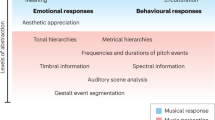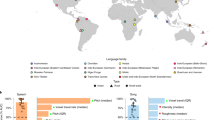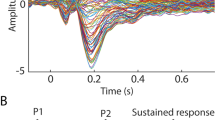Abstract
Music is characterized by acoustic forms that are predictive of its behavioural functions. For example, adult listeners accurately identify unfamiliar lullabies as infant-directed on the basis of their musical features alone. This property could reflect a function of listeners’ experiences, the basic design of the human mind, or both. Here, we show that US infants (N = 144) relax in response to eight unfamiliar foreign lullabies, relative to matched non-lullaby songs from other foreign societies, as indexed by heart rate, pupillometry and electrodermal activity. They do so consistently throughout the first year of life, suggesting that the response is not a function of their musical experiences, which are limited relative to those of adults. The infants’ parents overwhelmingly chose lullabies as the songs that they would use to calm their fussy infant, despite their unfamiliarity. Together, these findings suggest that infants may be predisposed to respond to common features of lullabies found in different cultures.
This is a preview of subscription content, access via your institution
Access options
Access Nature and 54 other Nature Portfolio journals
Get Nature+, our best-value online-access subscription
$29.99 / 30 days
cancel any time
Subscribe to this journal
Receive 12 digital issues and online access to articles
$119.00 per year
only $9.92 per issue
Buy this article
- Purchase on Springer Link
- Instant access to full article PDF
Prices may be subject to local taxes which are calculated during checkout





Similar content being viewed by others
Data availability
All data reported here are available at https://github.com/themusiclab/infant-relax. Stimuli are available at https://osf.io/2t6cy. Audio excerpts from the Natural History of Song Discography are available at https://osf.io/vcybz; the full corpus can be explored interactively at https://themusiclab.org/nhsplots. For assistance with data or materials, please contact M.B., C.M.B. and S.A.M.
Code availability
A reproducible version of this manuscript, including all analysis and visualization code, is available at https://github.com/themusiclab/infant-relax. For assistance with code, please contact M.B., C.M.B. and S.A.M.
References
Mehr, S. A. et al. Universality and diversity in human song. Science 366, 957–970 (2019).
Jacoby, N. & McDermott, J. H. Integer ratio priors on musical rhythm revealed cross-culturally by iterated reproduction. Curr. Biol. 27, 359–370 (2017).
Jacoby, N. et al. Universal and non-universal features of musical pitch perception revealed by singing. Curr. Biol. 29, 3229–3243 (2019).
Ravignani, A., Delgado, T. & Kirby, S. Musical evolution in the lab exhibits rhythmic universals. Nat. Hum. Behav. 1, 0007 (2016).
Mendoza, J. K. & Fausey, C. M. Everyday music in infancy. PsyArXiv https://doi.org/10.31234/osf.io/sqatb (2019).
Custodero, L. A., Rebello Britto, P. & Brooks-Gunn, J. Musical lives: a collective portrait of American parents and their young children. J. Appl. Dev. Psychol. 24, 553–572 (2003).
Custodero, L. A. & Johnson-Green, E. A. Passing the cultural torch: musical experience and musical parenting of infants. J. Res. Music Educ. 51, 102–114 (2003).
Mehr, S. A. Music in the home: new evidence for an intergenerational link. J. Res. Music Educ. 62, 78–88 (2014).
Trehub, S. E., Hill, D. S. & Kamenetsky, S. B. Parents’ sung performances for infants. Can. J. Exp. Psychol. 51, 385–396 (1997).
Granier-Deferre, C., Bassereau, S., Ribeiro, A., Jacquet, A.-Y. & DeCasper, A. J. A melodic contour repeatedly experienced by human near-term fetuses elicits a profound cardiac reaction one month after birth. PLoS ONE 6, e17304 (2011).
Zentner, M. R. & Kagan, J. Perception of music by infants. Nature 383, 29 (1996).
Winkler, I., Háden, G. P., Ladinig, O., Sziller, I. & Honing, H. Newborn infants detect the beat in music. Proc. Natl Acad. Sci. USA 106, 2468–2471 (2009).
Hannon, E. E., Schachner, A. & Nave-Blodgett, J. E. Babies know bad dancing when they see it: older but not younger infants discriminate between synchronous and asynchronous audiovisual musical displays. J. Exp. Child Psychol. 159, 159–174 (2017).
Hannon, E. E. & Trehub, S. E. Tuning in to musical rhythms: infants learn more readily than adults. Proc. Natl Acad. Sci. USA 102, 12639–12643 (2005).
Mehr, S. A., Song, L. A. & Spelke, E. S. For 5-month-old infants, melodies are social. Psychol. Sci. 27, 486–501 (2016).
Mehr, S. A. & Spelke, E. S. Shared musical knowledge in 11-month-old infants. Dev. Sci. 21, (2017).
Trainor, L. J., Wu, L. & Tsang, C. D. Long-term memory for music: infants remember tempo and timbre. Dev. Sci. 7, 289–296 (2004).
Volkova, A., Trehub, S. E. & Schellenberg, E. G. Infants’ memory for musical performances. Dev. Sci. 9, 583–589 (2006).
Hrdy, S. B. Mothers and Others: The Evolutionary Origins of Mutual Understanding (Harvard University Press, 2009).
Trivers, R. L. in Sexual Selection and the Descent of Man (ed. Campbell, B. G.) 136–179 (Aldine, 1972).
Soltis, J. The signal functions of early infant crying. Behav. Brain Sci. 27, 443–458 (2004).
Mehr, S. A. & Krasnow, M. M. Parent–offspring conflict and the evolution of infant-directed song. Evol. Hum. Behav. 38, 674–684 (2017).
Mehr, S. A., Krasnow, M., Bryant, G. A. & Hagen, E. H. Origins of music in credible signaling. Behav. Brain Sci. https://doi.org/10.1017/S0140525X20000345 (2020).
Haig, D. & Wharton, R. Prader–Willi syndrome and the evolution of human childhood. Am. J. Hum. Biol. 15, 320–329 (2003).
Ubeda, F. Evolution of genomic imprinting with biparental care: implications for Prader–Willi and Angelman syndromes. PLoS Biol. 6, 1678–1692 (2008).
Cassidy, S. B. & Driscoll, D. J. Prader–Willi syndrome. Eur. J. Hum. Genet. 17, 3–13 (2008).
Williams, C. A. et al. Angelman syndrome 2005: updated consensus for diagnostic criteria. Am. J. Med. Genet. 140, 413–418 (2006).
Mehr, S. A., Kotler, J., Howard, R. M., Haig, D. & Krasnow, M. M. Genomic imprinting is implicated in the psychology of music. Psychol. Sci. 28, 1455–1467 (2017).
Kotler, J., Mehr, S. A., Egner, A., Haig, D. & Krasnow, M. M. Response to vocal music in Angelman syndrome contrasts with Prader–Willi syndrome. Evol. Hum. Behav. 40, 420–426 (2019).
Maynard Smith, J. & Harper, D. Animal Signals (Oxford Univ. Press, 2003).
Morton, E. S. On the occurrence and significance of motivation-structural rules in some bird and mammal sounds. Am. Nat. 111, 855–869 (1977).
Owren, M. J. & Rendall, D. Sound on the rebound: bringing form and function back to the forefront in understanding nonhuman primate vocal signaling. Evol. Anthropol. 10, 58–71 (2001).
Endler, J. A. Some general comments on the evolution and design of animal communication systems. Philos. Trans. R. Soc. B 340, 215–225 (1993).
Filippi, P. et al. Humans recognize emotional arousal in vocalizations across all classes of terrestrial vertebrates: evidence for acoustic universals. Proc. R. Soc. B 284, (2017).
Moser, C. J. et al. Acoustic regularities in infant-directed vocalizations across cultures. bioRxiv https://doi.org/10.1101/2020.04.09.032995v1 (2020).
Fernald, A. Intonation and communicative intent in mothers’ speech to infants: is the melody the message? Child Dev. 60, 1497–1510 (1989).
Kuhl, P. K. et al. Cross-language analysis of phonetic units in language addressed to infants. Science 277, 684–686 (1997).
Piazza, E. A., Iordan, M. C. & Lew-Williams, C. Mothers consistently alter their unique vocal fingerprints when communicating with infants. Curr. Biol. 27, 3162–3167 (2017).
Broesch, T. & Bryant, G. A. Fathers’ infant-directed speech in a small-scale society. Child Dev. 89, e29–e41 (2018).
Bryant, G. A. & Barrett, H. C. Recognizing intentions in infant-directed speech: evidence for universals. Psychol. Sci. 18, 746–751 (2007).
Trehub, S. E., Unyk, A. M. & Trainor, L. J. Adults identify infant-directed music across cultures. Infant Behav. Dev. 16, 193–211 (1993).
Mehr, S. A., Singh, M., York, H., Glowacki, L. & Krasnow, M. M. Form and function in human song. Curr. Biol. 28, 356–368 (2018).
Trainor, L. J., Clark, E. D., Huntley, A. & Adams, B. A. The acoustic basis of preferences for infant-directed singing. Infant Behav. Dev. 20, 383–396 (1997).
Trehub, S. E. et al. Mothers’ and fathers’ singing to infants. Dev. Psychol. 33, 500–507 (1997).
Gomez, P. & Danuser, B. Relationships between musical structure and psychophysiological measures of emotion. Emotion 7, 377–387 (2007).
Rock, A., Trainor, L. & Addison, T. Distinctive messages in infant-directed lullabies and play songs. Dev. Psychol. 35, 527–534 (1999).
Tan, X., Yowler, C. J., Super, D. M. & Fratianne, R. B. The interplay of preference, familiarity and psychophysical properties in defining relaxation music. J. Music Ther. 49, 150–179 (2012).
Zajonc, R. B. Mere exposure: a gateway to the subliminal. Curr. Dir. Psychol. Sci. 10, 224–228 (2001).
Cirelli, L. K., Jurewicz, Z. B. & Trehub, S. E. Effects of maternal singing style on mother–infant arousal and behavior. J. Cogn. Neurosci. 37, 1213–1220 (2019).
Garunkstiene, R., Buinauskiene, J., Uloziene, I. & Markuniene, E. Controlled trial of live versus recorded lullabies in preterm infants. Nord. J. Music Ther. 23, 71–88 (2014).
Cirelli, L. K. & Trehub, S. E. Familiar songs reduce infant distress. Dev. Psychol. 56, 861–868 (2020).
Corbeil, M., Trehub, S. E. & Peretz, I. Singing delays the onset of infant distress. Infancy 21, 373–391 (2016).
Richards, J. E. & Cronise, K. Extended visual fixation in the early preschool years: look duration, heart rate changes, and attentional inertia. Child Dev. 71, 602–620 (2000).
Laeng, B., Sirois, S. & Gredebäck, G. Pupillometry: a window to the preconscious? Perspect. Psychol. Sci. 7, 18–27 (2012).
Bradley, M. M., Miccoli, L., Escrig, M. A. & Lang, P. J. The pupil as a measure of emotional arousal and autonomic activation. Psychophysiology 45, 602–607 (2008).
Laeng, B., Eidet, L. M., Sulutvedt, U. & Panksepp, J. Music chills: the eye pupil as a mirror to music’s soul. Conscious. Cogn. 44, 161–178 (2016).
Widmann, A., Schröger, E. & Wetzel, N. Emotion lies in the eye of the listener: emotional arousal to novel sounds is reflected in the sympathetic contribution to the pupil dilation response and the P3. Biol. Psychol. 133, 10–17 (2018).
Lakens, D., Scheel, A. M. & Isager, P. M. Equivalence testing for psychological research: a tutorial. Adv. Methods Pract. Psychol. Sci. 1, 259–269 (2018).
Shultz, S., Klin, A. & Jones, W. Inhibition of eye blinking reveals subjective perceptions of stimulus salience. Proc. Natl Acad. Sci. USA 108, 21270–21275 (2011).
Trehub, S. E. Musical predispositions in infancy. Ann. N. Y. Acad. Sci. 930, 1–16 (2001).
Hannon, E. E. & Trainor, L. J. Music acquisition: effects of enculturation and formal training on development. Trends Cogn. Sci. 11, 466–72 (2007).
Henrich, J., Heine, S. J. & Norenzayan, A. The weirdest people in the world? Behav. Brain Sci. 33, 61–83 (2010).
Sperber, D. & Hirschfeld, L. A. The cognitive foundations of cultural stability and diversity. Trends Cogn. Sci. 8, 40–46 (2004).
Blumstein, D. T., Bryant, G. A. & Kaye, P. The sound of arousal in music is context-dependent. Biol. Lett. 8, 744–747 (2012).
Trainor, L. J. Infant preferences for infant-directed versus noninfant-directed playsongs and lullabies. Infant Behav. Dev. 19, 83–92 (1996).
Sievers, B., Polansky, L., Casey, M. & Wheatley, T. Music and movement share a dynamic structure that supports universal expressions of emotion. Proc. Natl Acad. Sci. USA 110, 70–75 (2013).
Cowen, A. S., Fang, X., Sauter, D. & Keltner, D. What music makes us feel: at least 13 dimensions organize subjective experiences associated with music across different cultures. Proc. Natl. Acad. Sci. USA 117, 1924–1934 (2020).
Trehub, S. E. & Trainor, L. Singing to infants: lullabies and play songs. Adv. Infancy Res 12, 43–78 (1998).
Spokes, A. C. & Spelke, E. S. The cradle of social knowledge: infants’ reasoning about caregiving and affiliation. Cognition 159, 102–116 (2017).
Soley, G. & Sebastián-Gallés, N. Infants prefer tunes previously introduced by speakers of their native language. Child Dev. 86, 1685–1692 (2015).
Tsang, C. D., Falk, S. & Hessel, A. Infants prefer infant-directed song over speech. Child Dev. 88, 1207–1215 (2017).
Hole, J., Hirsch, M., Ball, E. & Meads, C. Music as an aid for postoperative recovery in adults: a systematic review and meta-analysis. Lancet 386, 1659–1671 (2015).
Richard-Lalonde, M. et al. The effect of music on pain in the adult intensive care unit: a systematic review of randomized controlled trials. J. Pain Symptom Manage. 59, 1304–1319 (2019).
Bieleninik, Ł., Ghetti, C. & Gold, C. Music therapy for preterm infants and their parents: a meta-analysis. Pediatrics 138, e20160971 (2016).
Bo, L. K., Mn, B. & Callaghan, P. Soothing pain-elicited distress in Chinese neonates. Pediatrics 105, e49–e49 (2000).
Keith, D. R., Russell, K. & Weaver, B. S. The effects of music listening on inconsolable crying in premature infants. J. Music Ther. 46, 191–203 (2009).
Filippa, M., Devouche, E., Arioni, C., Imberty, M. & Gratier, M. Live maternal speech and singing have beneficial effects on hospitalized preterm infants. Acta Paediatr. 102, 1017–1020 (2013).
Fancourt, D. & Perkins, R. Could listening to music during pregnancy be protective against postnatal depression and poor wellbeing post birth? Longitudinal associations from a preliminary prospective cohort study. BMJ Open 8, e021251 (2018).
Miller, C. L. Developmental changes in male/female voice classification by infants. Infant Behav. Dev. 6, 313–330 (1983).
van Lier, H. G. et al. A standardized validity assessment protocol for physiological signals from wearable technology: methodological underpinnings and an application to the E4 biosensor. Behav. Res. Methods 52, 607–629 (2020).
King, D. E. Dlib-ml: a machine learning toolkit. J. Mach. Learn. Res. 10, 1755–1758 (2009).
Datavyu Team. Datavyu: a video coding tool (Databrary Project, New York Univ., 2014).
Acknowledgements
We thank the infants and parents who participated in this research; J. Kominsky, N. Soja, W. Pepe, E. Spelke and S. Carey for their support with participant recruitment; H. Alton, A. Bergson, A. Bitran, G. Jessani, A. Keomurjian and B. Milosh for research assistance; and C. Payne and three anonymous reviewers for detailed and constructive feedback on the manuscript. This research was supported by the NIH Director’s Early Independence Award DP5OD024566, the Harvard University Department of Psychology and the Harvard Data Science Initiative. The funders had no role in the conceptualization, design, data collection, analysis, decision to publish, or preparation of the manuscript.
Author information
Authors and Affiliations
Contributions
S.A.M., S.A. and C.M.B. designed the research, supported with ideas from A.M. J.Y., C.M.B. and S.A. led data collection, assisted by M.B., L.Y., K.L. and F.X., under the supervision of S.A.M. M.B., J.S. and S.A.M. analysed the data. J.S. and S.A.M. designed the pupil annotation method. S.A.M. provided funding. M.B., J.Y., C.M.B. and S.A.M. wrote the manuscript, and all authors approved it.
Corresponding authors
Ethics declarations
Competing interests
The authors declare no competing interests.
Additional information
Peer review information
Primary handling editor: Charlotte Payne.
Publisher’s note Springer Nature remains neutral with regard to jurisdictional claims in published maps and institutional affiliations.
Supplementary information
Supplementary Information
Supplemental Figs. 1–4 and their legends.
Rights and permissions
About this article
Cite this article
Bainbridge, C.M., Bertolo, M., Youngers, J. et al. Infants relax in response to unfamiliar foreign lullabies. Nat Hum Behav 5, 256–264 (2021). https://doi.org/10.1038/s41562-020-00963-z
Received:
Accepted:
Published:
Issue Date:
DOI: https://doi.org/10.1038/s41562-020-00963-z
This article is cited by
-
Universality, domain-specificity and development of psychological responses to music
Nature Reviews Psychology (2023)
-
The (Co)Evolution of Language and Music Under Human Self-Domestication
Human Nature (2023)
-
A systematic review and Bayesian meta-analysis of the acoustic features of infant-directed speech
Nature Human Behaviour (2022)
-
Anticipatory regulation of cardiovascular system on the emergence of auditory-motor interaction in young infants
Experimental Brain Research (2022)
-
Acoustic regularities in infant-directed speech and song across cultures
Nature Human Behaviour (2022)



